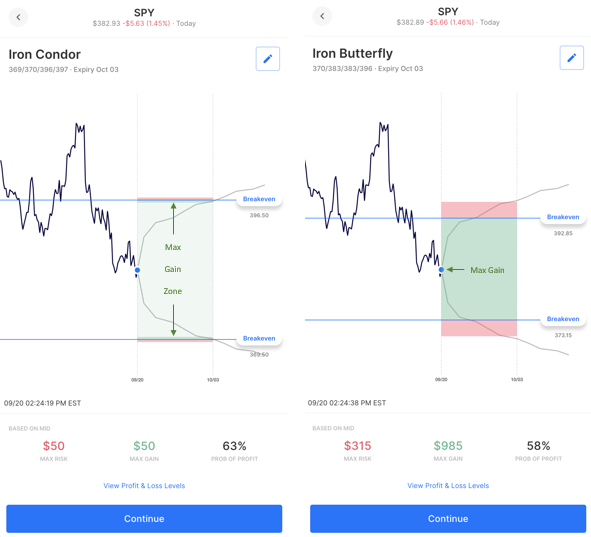DEEPER DIVE
Iron Condor vs Butterfly
Both the Iron Condor and the Iron Butterfly are income generating strategies that profit if a stock trades within a range. Used by investors with a generally neutral view or a belief that there will be a decline in volatility.
Both are also four-leg strategies that may be seen as combining a Credit Call Spread and a Credit Put Spread. The key difference being that with an Iron Condor we set our short (Call and Put) strikes apart and with an Iron Butterfly we sell a same strike Call and Put.
However, there are other key differences which have important implications for when and how each strategy might be used.
To explore these differences in more detail, let’s compare two hypothetical strategy setups, using SPY as the underlying stock/ETF.
Comparison Setup
For this example, we make the following assumptions:
- The SPY ETF is currently trading around $383
- The Expected Move for our expiration date is approximately 3.5%, implying a move to around $ $396 to the upside and $370 to the downside.
We use these expected move levels to guide selection in the following ways:
Iron Condor 369/370/396/397
- Short Call and short Put are set at the expected move level (396 and 370 respectively) and each spread set with one strike width.
Iron Butterfly 370/383/383/396
- Short Call and Short Put are set at-the-money (383) with each ‘wing’ (long Call and long Put) set at the expected move level (396 and 370 respectively).
As a result we have two broadly comparable strategies, each generating income for the investor if the underlying stock stays within the expected move (i.e. profiting if SPY moves less than the market expects) and each with defined risk.
Visual Comparison

This visual comparison using the Options AI platform helps highlight the key differences between the two strategies.
Firstly, with the Iron Condor we see a Max Gain zone (light green) ranging from our short Call and short Put strike levels. If the stock trades within this zone at expiration, we have the opportunity to keep all of the premium we collected. By contrast, the Iron Butterfly has only a single point of Max Gain (since we set both our short Call and short Put at the same strike). Instead, we have a zone of diminishing profit (dark green) ranging from our short strike level, out to our upper and lower breakeven levels.
Since the Iron Butterfly has a precise point of hypothetical maximum gain (the short Call & Put strike), keeping our entire premium collected and maximizing profit is an unlikely outcome when using this strategy. For this to occur, it would mean the underlying stock closing precisely at the short strike price at expiration and for neither short option contract to be assigned. It follows therefore, that when using an Iron Butterfly we are typically hoping for a degree of profitability, while with an Iron Condor we are positioning for a more binary outcome (maximum gain or maximum loss).
Knowing the differing types of profit zone for each strategy, let’s now look at their respective risk to reward metrics.
With an Iron Condor, we are both selling and buying lower-cost, out-the-money options. With an Iron Butterfly we are typically selling higher-value at-the-money (or close to it) options and buying lower-cost, out-the-money options. It follows therefore, that we typically collect less net premium when opening an Iron Condor than when opening a comparable Iron Butterfly. In the example above, we collect $50 in income for opening 1 Iron Condor compared to $985 for opening 1 Iron Butterfly. This also being our maximum potential profit.
However, since the width of the Credit Call and Credit Put Spread that comprise our Iron Condor is narrower than those that comprise our Iron Butterfly, our maximum risk is also typically lower with an Iron Condor. In the example above, we risk $50 with 1 Iron Condor compared to $315 with 1 Iron Butterfly.
Putting maximum profit and loss together, we therefore see that an Iron Butterfly typically has a lower risk to reward ratio than a comparable Iron Condor, as well as both a higher maximum profit and maximum loss potential in dollar terms.
While the Credit Call Spread and Credit Put Spread that comprise both an Iron Condor and an Iron Butterfly are typically set at constant widths, it is worth noting that this does not have to be the case. If each of the two spreads are different widths, the maximum risk of the trade is calculated by taking the wider of the two spreads and subtracting the net premium received.
Also worth noting is that while the short strikes of an Iron Butterfly are typically set at-the-money or close to it, they may also be set with a directional skew. For example, with a view that a stock may move to an upside price target and then range trade around that level, an investor may use an Iron Condor to target that price by setting the short strikes at that level.
Finally, we know that both an Iron Condor and an Iron Butterfly typically see a probability of profit in excess of 50%. However, we have also seen the key difference between the two strategies in terms of likelihood of realizing maximum gain. So, it is particularly important to be mindful of this difference and that we are assessing the probability of any profit when choosing between an Iron Condor and Iron Butterfly.
